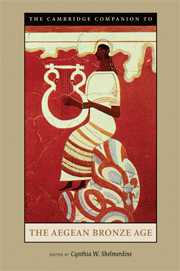Book contents
- Frontmatter
- 1 Background, Sources, and Methods
- 2 The Early Bronze Age in Greece
- 3 The Early Bronze Age in the Cyclades
- 4 Early Prepalatial Crete
- 5 Protopalatial Crete
- 6 The Material Culture of Neopalatial Crete
- 7 Minoan Culture: Religion, Burial Customs, and Administration
- 8 Minoan Crete and the Aegean Islands
- 9 Minoan Trade
- 10 Early Mycenaean Greece
- 11 Mycenaean Art and Architecture
- 12 Mycenaean States
- 13 Burial Customs and Religion
- 14 Mycenaean Greece, the Aegean and Beyond
- 15 Decline, Destruction, Aftermath
- Glossary
- Select Bibliography
- Index
- Plate section
9 - Minoan Trade
Published online by Cambridge University Press: 28 November 2010
- Frontmatter
- 1 Background, Sources, and Methods
- 2 The Early Bronze Age in Greece
- 3 The Early Bronze Age in the Cyclades
- 4 Early Prepalatial Crete
- 5 Protopalatial Crete
- 6 The Material Culture of Neopalatial Crete
- 7 Minoan Culture: Religion, Burial Customs, and Administration
- 8 Minoan Crete and the Aegean Islands
- 9 Minoan Trade
- 10 Early Mycenaean Greece
- 11 Mycenaean Art and Architecture
- 12 Mycenaean States
- 13 Burial Customs and Religion
- 14 Mycenaean Greece, the Aegean and Beyond
- 15 Decline, Destruction, Aftermath
- Glossary
- Select Bibliography
- Index
- Plate section
Summary
Introduction
Cretans have always looked to the sea. Crete is the largest of the Aegean islands, and it has many fine harbors. The mountainous landscape that causes the many indentations at the coast and creates the favorable shelters for shipping also makes travel by land difficult, especially for the transport of heavy goods. As a result, even trade within Crete itself has often used the sea instead of moving overland.
The predecessors of the people we call the Minoans had to travel by sea to settle the island. They found ample room for agriculture and for the raising of animals, but their new homeland lacked many of the natural resources they required; maritime commerce to acquire needed commodities was an easy solution for people who were already seafarers. It is not surprising that the Cretans began obtaining raw materials and other items overseas almost immediately, and that they would continue to regard seafaring as an integral part of their lifestyle.
The Neolithic and Early Minoan Periods
The earliest known evidence for settlement on Crete comes from Knossos, from the Early Neolithic period (Ch. 4, p. 80). The site in northcentral Crete was first settled in the seventh millennium bce, and it was already an important town during the Neolithic period; in the Late Bronze Age, it would become the largest palatial center in Crete. Obsidian from the island of Melos was well known to the Neolithic Knossians, and it was regularly brought into Crete either by exchange or by voyaging to the Cycladic island to obtain pieces of the useful volcanic glass.
- Type
- Chapter
- Information
- The Cambridge Companion to the Aegean Bronze Age , pp. 209 - 229Publisher: Cambridge University PressPrint publication year: 2008
- 3
- Cited by



